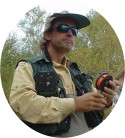6- I wonder what to tie on now
After a rejection, Paco opts for changing flies. Choosing a pattern is another crucial moment, more crucial for some than for others. Some points to bear in mind:


- Although a lot of fishermen keep changing flies in this situation, it's a fairly unproductive hit-and-miss system.
- A dry fly won't float as well as on the first cast no matter how much you try to dry it.
- Instead of changing patterns, you might try a different size or flotation level (for example, half in and half out of the water) within the same pattern.
- Changing flies might not be the best option after a rejection. You should first change the angle of presentation, try a different type of cast or lengthen your leader.
- Sometimes the only difference between an effective pattern and a useless fly is a quick trim of a few hairs or fibers and a tiny strip of Velcro, which your vest should never be without.
- When all else fails, the only thing left to do is to make a cast with history-making accuracy to land the fly just over the trout's neck. When it turns to see what has swished the water, it'll gulp it without a second thought. Maybe...

7- The magic moment
For some, this is the most special of all possible moments in fly fishing. Following this fraction of a second when you feel the tautness of the line, the rest is something to be done as quickly and accurately as possible. To store the surplus line on the real as fast as possible, the best thing is to reel it in with your dominant hand. Changing the rod to your other hand is a good option if you want to avoid problems by getting rid of all the line floating on the water as soon as possible.

A piece of advice for quickly playing the fish to the net as soon as possible: different rod positions exert different amounts of pressure on the fish. When the rod butt is at a 90º angle in relation to the line, the pressure is minimum. At 45º, the pressure is maximum and forces the fish to make the greatest effort. Consequently, it will tire sooner. When possible, also change the direction from which you apply the pressure. This confuses the fish and reduces its options to find protection in its usual hideaway.


